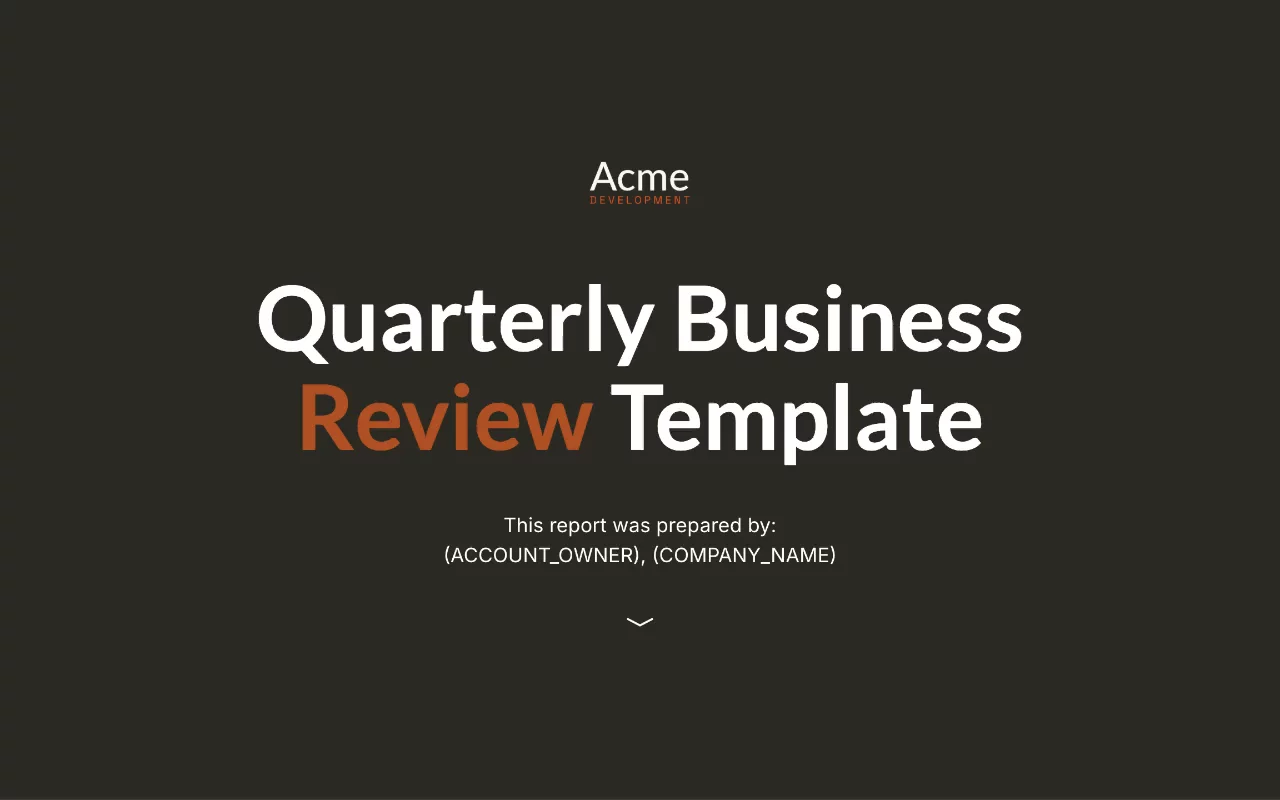Quarterly Business Review (QBR) Template
Drive business growth with our actionable QBR Template – create an insightful, detailed, and effective review for your clients.

About this template
Enhance your QBR meetings with our visually appealing and easy-to-use Quarterly Business Review Template. Designed to showcase performance metrics and insights, this template helps identify areas of improvement and drive strategic planning.
What's included?
- Executive summary
- Goals summary
- Business recommendations
- Link to product pitch deck
- Embeddable data dashboard
- Pricing information
- ROI calculator
- Next steps
Included in our template
Executive summary
Start strong with a concise executive summary that outlines key wins, high-level performance metrics, and notable developments from the quarter. This section is designed to help busy executives get the big picture fast—without digging through slides or data dumps. It’s your opportunity to frame the narrative and signal the value you’ve delivered before diving into the details.

Goal summary
In this section, you’ll tie back to the client’s original objectives—whether that’s revenue growth, customer acquisition, operational efficiency, or campaign performance. The Quarterly Business Review template makes it easy to track progress against those goals, celebrate milestones, and identify where additional support may be needed. It’s structured to keep the QBR aligned with client priorities, helping you build trust and position your team as an ongoing partner in success.

Client dashboard
Ditch the outdated charts. The QBR template includes a section where you can embed live dashboards from Looker, Tableau, or Google Data Studio—giving clients real-time visibility into their metrics. Whether it’s MQLs, NPS, churn, revenue impact, or campaign performance, your clients can see exactly what’s happening without waiting for a static PDF. This makes your QBR not just a report, but a live, interactive performance hub

Add-on pricing packages
The best time to expand an account is when you’re already proving value. This section helps you introduce add-on services or upsell packages within the context of your QBR—at the moment when trust is highest. Whether it’s additional consulting hours, upgraded features, or premium support tiers, you can clearly present pricing options in an interactive, easy-to-understand format. It turns your QBR into a launchpad for revenue expansion.

ROI calculator
Move from “here’s what we did” to “here’s what it’s worth.” The QBR template includes a built-in ROI calculator to help quantify business impact. You can customize it to reflect your unique value metrics—such as cost savings, revenue lift, time saved, or process improvements. This section helps you clearly demonstrate ROI and make a compelling case for continued investment in your services.

Embedded calendar
End your QBR with a simple next step. The final section allows you to embed your booking calendar directly into the proposal, making it easy for clients to book a follow-up strategy session, renewal conversation, or check-in. By removing friction, you ensure the QBR doesn’t end with a thank-you—it ends with action.

Why Qwilr?
Design interactive proposals
Impress buyers with interactive proposals that stand out. Qwilr’s drag-and-drop editor makes it easy to create on-brand, stunning collateral — no design skills needed. Add videos, dynamic pricing, and ROI calculators to deliver a unique experience, while automated brand customizations ensure every proposal looks professional.

Built-in e-sign functionality
Combine stunning proposals, plain-text agreements, and secure e-signatures in one tool. Add print-friendly agreements alongside dynamic content and collect legally compliant e-signatures with ease. Track progress, capture multiple signatures, and close deals faster with Qwilr’s integrated e-sign functionality.

Real-time proposal analytics
Qwilr’s analytics provide full visibility into buyer engagement. Track when proposals are opened, signed, or shared, and get instant notifications for key buyer activities. See what buyers click on, how they engage, and prioritize follow-ups based on real-time insights—all designed to help close deals faster.

Templates for every use case
Explore templates for sales, marketing, customer success, sales enablement and more.
Explore customer success templatesFrequently asked questions
The key to writing a successful QBR is to remain objective and focus on the data. Start by reviewing your KPIs, analyzing trends, and comparing performance to previous quarters. Then, identify challenges and create action plans to address them. Finally, set clear, measurable goals for the upcoming quarter.
An internal QBR should cover all aspects of the business, including finance, operations, sales, and marketing. It should include KPIs, trends, challenges, and goals for each department.
To effectively run an effective QBR, it's important to plan with a clear outcome in mind and align the meeting to this goal.
Prioritize preparation by gathering all necessary data, distributing the agenda, and setting objectives for your team. During the meeting, promote open discussion, stay focused on the data, and establish clear goals that align with your desired outcome.
An effective QBR should include:
- KPIs and metrics
- Financial performance, including revenue and profit margins
- Operational performance, including efficiency and productivity
- Marketing performance, including lead generation and conversion rates
- Sales performance, including revenue and pipeline
- Challenges and opportunities
- Action plans
- Goals and objectives for the upcoming quarter
There are several ways to structure a QBR. However, a common approach is to begin with a financial review, followed by an operational review, sales review, marketing review, and challenges and opportunities discussion. Finally, set goals and objectives for the upcoming quarter.





